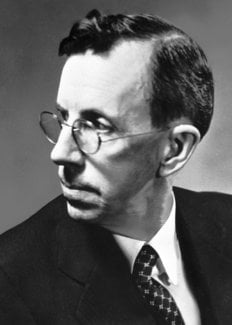Clinton Davisson
Biographical

Clinton Joseph Davisson was born at Bloomington, Illinois, U.S.A., October 22, 1881, son of Joseph Davisson, an artisan, native of Ohio, descendant of early Dutch and French settlers of Virginia, Union veteran of the American Civil War, and Mary Calvert, a school-teacher, native of Pennsylvania, of English and Scotch parentage.
He attended the Bloomington public schools, and on graduation from High School in 1902 was granted a scholarschip by the University of Chicago for proficiency in mathematics and physics. In September of that year he entered the University of Chicago and came at once under the influence of Professor R.A. Millikan. Unable for financial reasons to continue at Chicago the following year he found employment with a telephone company in his home town. In January 1904 he was appointed assistant in physics at Purdue University on recommendation of Professor Millikan. He returned to Chicago in June 1904 and remained in residence at the University until August 1905. In September 1905, again on the recommendation of Professor Millikan, he was appointed part-time instructor in physics at Princeton University. This post he held until 1910, studying, as his duties permitted, under Professor Francis Magie, Professor E. P. Adams, Professor ( later Sir ) James Jeans and particularly under Professor O.W. Richardson. During a part of this period Davisson returned to the University of Chicago for the summer sessions and in August 1908 received a B.S. degree from that institution.
He was awarded a Fellowship in Physics at Princeton for the year 1910-1911 and during that year completed requirements for the degree of Ph.D. which he received dune 1911. His thesis, under Professor Richardson, was On The Thermal Emission of Positive Ions From Alkaline Earth Salts.
From September 1911 until June 1917 he was an instructor in the Department of Physics at the Carnegie Institute of Technology, Pittsburgh, Pa. During the summer of 1913 he worked in the Cavendish Laboratory under Professor (later Sir) J.J. Thomson.
In April 1917 he was refused enlistment in the United States Army. In June of the same year he accepted war-time employment in the Engineering Department of the Western Electric Company (later Bell Telephone Laboratories), New York City – at first for summer, then, on leave of absence from Carnegie Tech., for the duration of the World War. At the end of the war he resigned an assistant professorship to which he had been appointed at Carnegie Tech. to continue as a Member of the Technical Staff of the Telephone Laboratories.
The series of investigations which led to the discovery of electron diffraction in 1927 was begun in 1919 and was continued into 1929 with the collaboration first of Dr. C.H. Kunsman, and from 1924 on, of Dr. L.H. Germer. During the same period researches were carried on in thermal radiation with the collaboration of Mr. J.R. Weeks, and in thermionics with Dr. H.A. Pidgeon and Dr. Germer.
From 1930-1937 Dr. Davisson devoted himself to the study of the theory of electron optics and to applications of this theory to engineering problems. He then investigated the scattering and reflection of very slow electrons by metals. During World War II he worked on the theory of electronic devices and on a variety of crystal physics problems.
In 1946 he retired from Bell Telephone Laboratories after 29 years of service. From 1947 to 1949, he was Visiting Professor of Physics at the University of Virginia, Charlottesville, Va.
In 1928 he was awarded the Comstock Prize by the National Academy of Sciences, in 1931 the Elliott Cresson Medal by the Franklin Institute, and in 1935 the Hughes Medal by the Royal Society (London), and in 1941 the Alumni Medal by the University of Chicago. He held honorary doctorates from Purdue University, Princeton University, the University of Lyon and Colby College.
In 1911 he married Charlotte Sara Richardson, a sister of Professor Richardson. He died in Charlottesville on February 1, 1958, at the age of 76, and was survived by his wife, three sons and one daughter.
This autobiography/biography was written at the time of the award and later published in the book series Les Prix Nobel/ Nobel Lectures/The Nobel Prizes. The information is sometimes updated with an addendum submitted by the Laureate.
Nobel Prizes and laureates
Six prizes were awarded for achievements that have conferred the greatest benefit to humankind. The 12 laureates' work and discoveries range from proteins' structures and machine learning to fighting for a world free of nuclear weapons.
See them all presented here.
